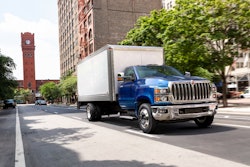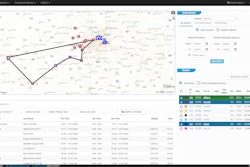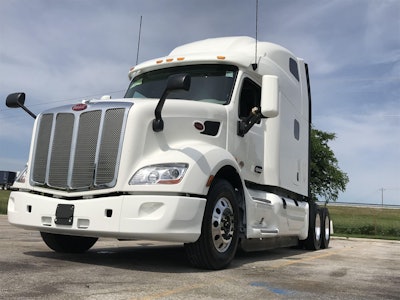
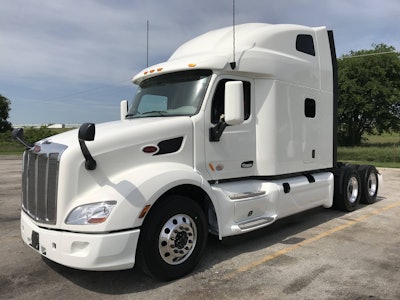
Pete’s traditional discrete sleepers feature a flat top with an added roof fairing for better long-haul aerodynamics – a riveted assembly that creates aero-inefficient seams and leaves a lot to be desired in the way of overhead space.
With body panels and rivets minimized, and drip trays eliminated, the integrated UltraLoft features flat, smooth and more aerodynamic sides. A redesigned sun visor forces wind over the visor, creating a low-pressure zone that helps pull the cab forward. Overall, the UltraLoft offers about a 2 percent gain in aerodynamics versus its discrete counterpart. That translates to a fuel economy gain of about 1 percent. If you want to bump the fuel efficiency a little more, the UltraLoft is available with Peterbilt’s Epiq aerodynamic package.
Adding a roof fairing may do a lot for a discrete sleeper’s aerodynamics but it does nothing for the driver’s headroom. The integral UltraLoft takes all the space previously wasted between the top of the sleeper and the roof fairing and gives it to the driver. While the difference between the two may not be obvious from the outside, the amount of extra available space is noticeable the moment you pull on the grab-handle to boost yourself into the truck.
I took an UltraLoft-equipped Model 579, outfitted with a Cummins X15 Efficiency Series and Eaton Endurant AMT, on a 125-mile trip from Peterbilt’s Denton, Texas assembly plant to Marietta, Okla., and the cockpit environment is unmistakably larger, if not downright comfortable.
When seated and my arms fully extended upward, I couldn’t reach the top of the cab. It doesn’t feel like the headliner is hovering right over you.
At 5’9″, I could easily stand between the seats and walk back to the bunk without smacking my head or having to stoop over. The transition from front to back is also more seamless as the cab’s integrated design eliminates the step-up ridge between the cockpit and sleeper. That’s one less thing to trip over.
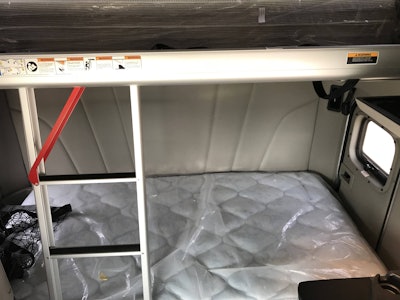 The upper bunk, capable of supporting 400 pounds, is accessed by an integrated telescopic ladder.
The upper bunk, capable of supporting 400 pounds, is accessed by an integrated telescopic ladder.The single bunk UltraLoft boasts 70 cubic feet of storage, while the double bunk configuration offers 64 cubic feet.
Wesley Slavin, Peterbilt’s on highway market segment manager for Peterbilt, says many fleets are opting to spec the double dunk even if they don’t plan to run a team of drivers.
“That’s mostly due to their resale value and having that extra bunk does give you a little added flexibility,” he says.
A split upper-bunk, when folded up, provides more headroom and 14 more cubic feet of storage. Peterbilt also added lockable storage bins above both doors with enough space to accommodate two CPAP machines. For team drivers, that potentially takes two things off the floor and helps prevent dirt from getting into the mask. An added bonus is both machines can be plugged in closer to each bunk, getting more wires and tubes off the floor.
With all the available storage, drivers won’t have to use the floor as a viable storage option, freeing existing space of clutter and making the interior feel that much larger.
The closet, with the hanging rod mounted higher in the unit, has a 42-inch hanging height – more than enough space for the big and tall.
A 1.1-cubic foot microwave option also is available and there’s room for a 32-inch flat-screen TV on the foot wall of the lower bunk. A new HVAC system, with rear- and side-mounted vents close to both bunks, helps increase air flow through the sleeping quarters.
Built on the 2.1-meter cab platform, the UltraLoft’s bunk mattresses are the largest available – 85-inches by 42-inches on the lower and 82-inches by 36-inches on the upper bunk, which is capable of supporting 400 pounds. Both bunks feature ample headroom, with 48-inches for the lower bunk and 39-inches for the top bunk. There’s plenty of headroom in both bunks to sit up and work on a laptop without smashing your head and power for charging is easily accessible at both locations.
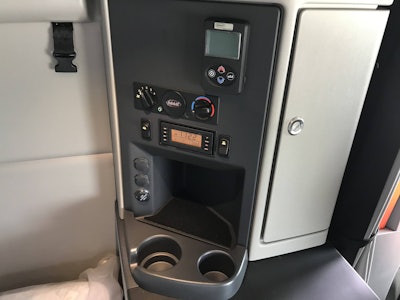 Working in the bunk is easy thanks to a slide-out table on the driver’s side and 12-volt, 110-volt and USB power ports in a panel behind the driver’s seat.
Working in the bunk is easy thanks to a slide-out table on the driver’s side and 12-volt, 110-volt and USB power ports in a panel behind the driver’s seat.Working and eating in the bunk is easy thanks to a slide-out table on the driver’s side and 12-volt, 110-volt and USB power ports in a panel behind the driver’s seat. A similar panel is installed in the upper bunk. The person sleeping up top also has ample access to LED lighting controls and the ability to lock the truck doors without getting out of bed.
With 2,000 units already on order, the UltraLoft is well on its way to being the on-highway long-haul champion for the Model 579. However, Slavin says there are no plans to discontinue any of the discrete options for fleets that change out sleepers as they trade trucks or for applications like flatbed and bulk-haul where flattop sleepers are more prevalent.
I wouldn’t be surprised to see applications that generally spec Peterbilt’s 72-inch discrete sleeper migrate toward the 80-inch UltraLoft assuming they’re willing to take on some extra wheelbase. The extra 8 inches of sleeper depth feels like a lot more thanks to all the bonus headroom and storage potential that come with it.
The overall experience in the UltraLoft is a comfortable one. It’s easy to move around, stand and work in what is ordinarily a more confined space.
Production of the UltraLoft is set to kickoff in July.



